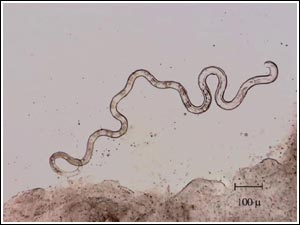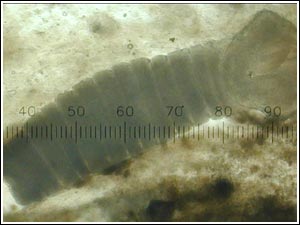

 |
||||||||||||
 |
||||||||||||
| Nematode (Roundworm) Infections in Fish | ||||||
| Roy P. E. Yanong | ||||||
Introduction Nematodes, or roundworms, infect many different species of aquacultured and wild fish. Small numbers of nematodes often occur in healthy fish, but high numbers will cause illness or even death. In aquaculture systems, brood stock infected with a small number of nematodes may not even show signs of illness, but often have reduced productivity rates. On the other hand, juvenile fish infected by small numbers of nematodes are more likely to show signs of illness and also have reduced growth rates. In aquaculture situations, fish become infected with nematodes if they are fed live foods containing infective life stages or if they are raised in culture settings that promote the growth of other animals that allow nematodes to complete their life cycle (intermediate hosts) or carry the infective stages of the nematode (vector or paratenic host). Finally, some nematodes can be transmitted directly from fish to fish. Adult nematodes are typically found in fish digestive tracts. However, depending upon the species of nematode and the species of infected fish, adult and other life stages of nematodes can be found in almost any part of the fish, including the internal organs, the swim bladder, deeper layers of the skin or fins, and external muscle layers. Prevention, proper identification, and correct therapy for treatable infestations dramatically improve the health and productivity of affected fish. Identification Identification is best done with a microscope. Nematodes are smooth, cylindrical, relatively long worms ( Figure 1 ), which distinguishes them from the flatter, segmented tapeworms ( Figure 2 ) and from the stouter and shorter monogenes (flukes) ( Figure 3 ). Pentastomids ( Figure 4 ) are another group of parasites that can be confused with nematodes, but they are considerably more stout and have more visible segmentation. Acanthocephalans ( Figure 5 ) are also somewhat similar in appearance, but they have a characteristic "thorny head" their head region is armed and encircled with numerous rows of hooks.  Figure 1: Photomicrograph of a Capillaria nematode showing typical nematode shape.
Figure 1: Photomicrograph of a Capillaria nematode showing typical nematode shape.
 Figure 2: Photomicrograph of a tapeworm showing typical segmentation (scale in micrometers - tapeworms can be much longer than the one shown).
Figure 2: Photomicrograph of a tapeworm showing typical segmentation (scale in micrometers - tapeworms can be much longer than the one shown).
more ... |
 |
|||||
| About Us :: Message Board :: Chat | |||||
| Library :: Photo Gallery :: Links & Resources :: Breeders & Sponsors :: Merchandise | |||||
| Website designed by: EthanCote.com | © 2001-2004, SimplyDiscus.com. All Rights Reserved. | ||||